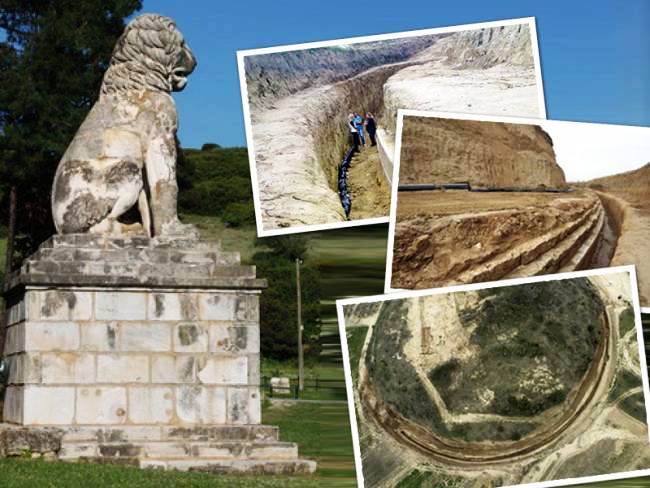
"The sphinxes are probably ready to reveal their secrets," says Greek culture minister Konstantinos Tasoulas, sitting in his central Athens office talking about the mystery surrounding the "unique" archaeological excavation in the northern town of Amphipolis, which continues to grip his nation.
In the past three months, those working on the dig have made their way through three impressive tomb chambers unearthing piece after piece of magnificent art, starting with the large tomb's entrance, flanked by two headless sphinxes, mythological creatures thatare part lion, part bird and part human.
Archaeologists have continued to dig beneath the floor, searching for a potential fourth chamber and uncovering an underground trench with the remains of a marble door.
Since the summer, the 30-strong team supervised by archaeologist Katerina Peristeri have found two colossal caryatids, female marble statues standing more than two metres high, wearing tunics with rich folds. Another chamber has a floor covered in a detailed and brightly coloured pebble mosaic in white, blue, grey, red and yellow, depicting the abduction of Persephone on a two-horse chariot by Hades, the god of the underworld.
The large mound enclosing the grave is surrounded by a 497-metre circular wall made of marble from the nearby island of Thassos. It is believed to be the largest ancient tomb ever discovered in Greece. Although no human remains have yet been found, archaeologists said the mythical scene of Persephone, also seen in the nearby Macedonian royal tombs of Vergina where Alexander the Great's father was buried, confirms the site is a tomb.
"It is a unique monument because of its size and art, which is fantastic," Mr Tasoulas told The Independent on Sunday. He has visited the site with Prime Minister Antonis Samaras. "[The builders] wanted to express power, the power of this very area of [northern] Greece, Macedonia; and obviously power of the person who is buried within it."
Dr Peristeri has dated the tomb to the late fourth century BC, after the death of Alexander the Great, causing speculation that the king himself could be buried there – although this is now seen as unlikely. After he died in Babylon in 323BC, Alexander's body was seized by his general Ptolemy and buried in Egypt.
Dr Peristeri has said that deciding who was buried there would have to wait until the excavation had finished, which could take years. "Certainly it's an extremely important person, an important general, she said. "We can't say [who it is] before the end of the excavation."
Although a small town now, Amphipolis used to be an important naval base from where Alexander launched his ships to conquer Persia. "It is a puzzle for decades to come. This is by far the most impressive tomb ever found in Greece," said Dorothy King, a US archaeologist based in London. She argues the tomb could have been built for Alexander, even if he didn't end up being buried there.
"Most tombs were started before the person died. We know that he wanted a magnificent tomb in Macedonia, and it is at the right date and the sort of tomb that Alexander would have wanted," she said.
While many archaeological digs throughout Greece are struggling because of funding cuts after the financial crisis, the culture ministry has vowed to continue the work at Amphipolis. "If more money is needed we will provide it," Mr Tasoulas said. "It's not a matter of cost but of unveiling the whole site."

Greek culture minister Konstantinos Tasoulas with Amal Clooney (Getty)
Over the past four years, debt?strapped Greece has invested €590,000 (£466,000) in the excavation. Authorities have taken measures to protect the site and its workers from the rain and harsh winter ahead, including building a sewage system and installing lightning rods.
Iron columns and expert tunnel engineers were brought in to ensure the site's stability, while security has also been boosted around the area to protect the site from "unwanted visitors". Evidence suggests the site has been looted in the distant past. Dr Peristeri says that if this was indeed the case, it would add evidence to the claim that an important person could have been buried there.
The potential for unwanted visitors is one way of highlighting the attention the dig has received in Greece, with the first video footage of the excavation, recently released by the culture ministry being one of the latest item to hit news channels across the country. Photographs of the site are also regularly distributed by the culture ministry.
"This great interest of the Greek public for the Amphipolis excavation has to do with the inner pride that every Greek feels about our heritage," Mr Tasoulas said. "[It] gives us strength for surpassing the present serious problems we face."
Historians also speculate that even if nothing new is found, the ancient mound could have other entrances leading to more finds.
"This is still the first chapter. There could still be more sets of chambers elsewhere in the tomb," said Dr King. "With such an important building, there [must have been] a lot of shrines and other buildings erected nearby.
"You don't find something like that in isolation."
Mr Tasoulas says the discovery of all the artefacts in the tomb means that "the best-case scenario has happened already – the monument has already spoken"
.
Πηγή




















